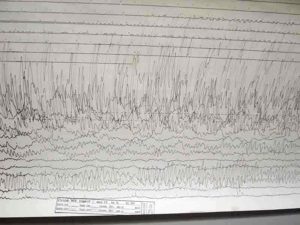
The world’s most powerful earthquakes strike at subduction zones, areas where enormous amounts of stress build up as one tectonic plate dives beneath another. When suddenly released, this stress can cause devastating “megaquakes” like the 2011 Mw 9.0 Tohoku event, which killed nearly 16,000 people and crippled Japan’s Fukushima Dai-ichi Nuclear Power Plant. Now a study published in Geology suggests that sediments atop the downgoing slab can play a key role in determining the magnitude and location of these catastrophic events.
In this newly published study, a team led by Gou Fujie, a senior scientist at the Japan Agency for Marine-Earth Science and Technology, used a trio of geophysical methods to image the subducting sediments in the northeastern Japan arc, where the Tohoku event occurred. The findings suggest that variations caused by volcanic rocks intruded into these sediments can substantially influence the nature of subduction zone earthquakes.
“Our imaging shows that the enormous amount of slip that occurred during the 2011 Tohoku earthquake stopped in an area of thin sediments that are just starting to subduct,” says Fujie. “These results indicate that by disturbing local sediment layers, volcanic activity that occurred prior to subduction can affect the size and the distribution of interplate earthquakes after the layers have been subducted.”
Researchers first began to suspect that variations in subducting sediments could influence megaquakes after the 2011 Tohoku event, when international drilling in the northeastern Japan arc showed that giant amounts of slip during the earthquake occurred in a slippery, clay-rich layer located within the subducting sediments. To better understand the nature of the downgoing slab in this region, Fujie’s team combined several imaging techniques to paint a clearer picture of the subseafloor structure.
The researchers discovered there are what Fujie calls “remarkable regional variations” in the sediments atop the downgoing plate, even where the seafloor topography seems to be flat. There are places, he says, where the sediment layer appears to be extremely thin due to the presence of an ancient lava flow or other volcanic rocks. These volcanic intrusions have heavily disturbed, and in places thermally metamorphosed, the clay layer in which much of the seismic slip occurred.
Because the type of volcanism that caused sediment thinning in the northeastern Japan arc has also been found in many areas, says Fujie, the research suggests such thinning is ubiquitous—and that this type of volcanic activity has also affected other seismic events. “Regional variations in sediments atop descending oceanic plates appear to strongly influence devastating subduction zone earthquakes,” he concludes.
Reference:
Gou Fujie et al. Spatial variations of incoming sediments at the northeastern Japan arc and their implications for megathrust earthquakes, Geology (2020). DOI: 10.1130/G46757.1
Note: The above post is reprinted from materials provided by Geological Society of America.










